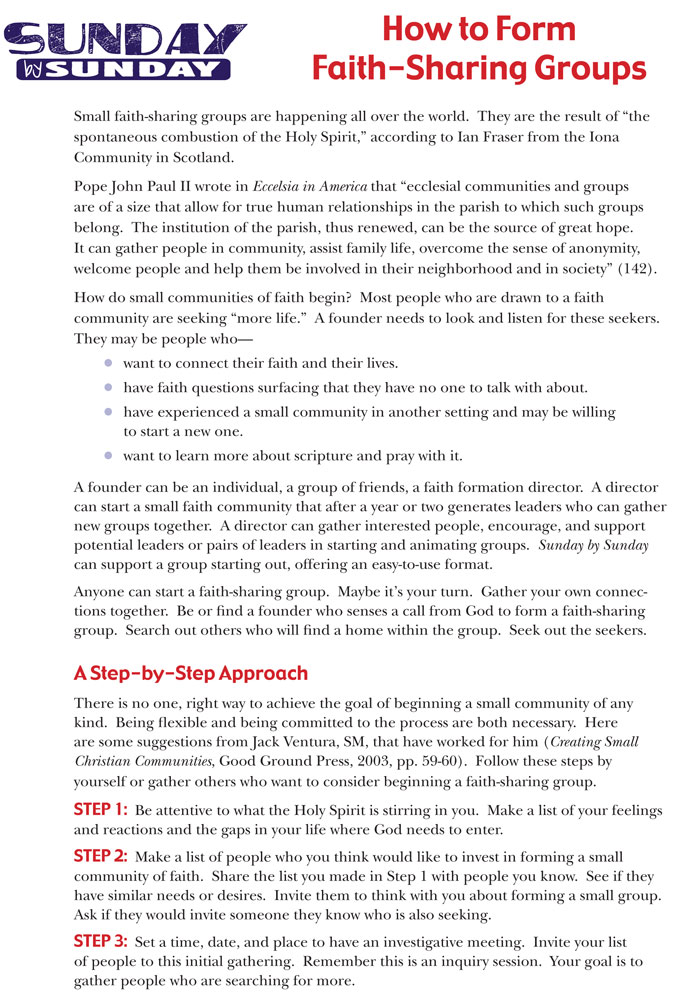Small faith-sharing groups are happening all over the world. They are the result of “the spontaneous combustion of the Holy Spirit,” according to Ian Fraser from the Iona Community in Scotland.
Pope John Paul II wrote in Eccelsia in America that “ecclesial communities and groups are of a size that allow for true human relationships in the parish to which such groups belong. The institution of the parish, thus renewed, can be the source of great hope.
It can gather people in community, assist family life, overcome the sense of anonymity, welcome people and help them be involved in their neighborhood and in society” (142).
How do small communities of faith begin? Most people who are drawn to a faith community are seeking “more life.” A founder needs to look and listen for these seekers. They may be people who—
- want to connect their faith and their lives.
- have faith questions surfacing that they have no one to talk with about.
- have experienced a small community in another setting and may be willing to start a new one.
- want to learn more about scripture and pray with it.
A founder can be an individual, a group of friends, a faith formation director. A director can start a small faith community that after a year or two generates leaders who can gather new groups together. A director can gather interested people, encourage, and support potential leaders or pairs of leaders in starting and animating groups. Sunday by Sunday can support a group starting out, offering an easy-to-use format.
Anyone can start a faith-sharing group. Maybe it’s your turn. Gather your own connec-tions together. Be or find a founder who senses a call from God to form a faith-sharing group. Search out others who will find a home within the group. Seek out the seekers.
A Step-by-Step Approach
There is no one, right way to achieve the goal of beginning a small community of any kind. Being flexible and being committed to the process are both necessary. Here
are some suggestions from Jack Ventura, SM, that have worked for him (Creating Small Christian Communities, Good Ground Press, 2003, pp. 59-60). Follow these steps by yourself or gather others who want to consider beginning a faith-sharing group.
STEP 1: Be attentive to what the Holy Spirit is stirring in you. Make a list of your feelings and reactions and the gaps in your life where God needs to enter.
STEP 2: Make a list of people who you think would like to invest in forming a small community of faith. Share the list you made in Step 1 with people you know. See if they have similar needs or desires. Invite them to think with you about forming a small group. Ask if they would invite someone they know who is also seeking.
STEP 3: Set a time, date, and place to have an investigative meeting. Invite your list
of people to this initial gathering. Remember this is an inquiry session. Your goal is to gather people who are searching for more.
STEP 4: Set a time limit. Be sure to communicate that to those you are inviting. This first gathering should not be longer than two hours.
STEP 5: Invite by mail and follow up by phone. Send a formal letter of invitation to the gathering. Be very specific about its purpose. Also, be clear that there are no commitments at this time. All you are trying to accomplish is to put out a possibility for the seekers. Some people may be interested; some may be interested but not able to attend the gathering, and some may say, “I have been waiting for something like this.”
STEP 6: Develop a plan for the gathering. Your gathering could proceed as follows.
- Social time until everyone has arrived.
- Opening prayer calling on the Holy Spirit.
- State purpose of gathering: to investigate the forming of a small faith community.
- Time for sharing personal needs, hopes, and expectations of the people gathered. Give each person a chance to talk, rather than responding quickly to what someone has just said.
- Are those gathered hearing similar needs and desires? Is there enough interest to start a small community? Is there a willingness to meet again?
- If yes, set the time and place for the next gathering.
- Pray to close the meeting part of your time together.
- Take more social time. People often share more at this time than in the actual meeting.
Your Next Step
Once you have a commitment from others to enter the journey of starting a small community of faith, the next few gatherings will be defining. Take as your own the motto of José Marins who formed small faith groups in Brazil. “Your group needs a minimum of structure and a maximum of life.” Some decisions:
- When and where to meet
- Frequency of meetings
- Purpose of the gatherings; vision for your group
- Style of a typical meeting
- Defining the size of a community. What is too small? What is too big?
- Expectations of the members
- Roles of the members; how you will share leadership
- Deciding style of prayer
- Defining a method for interpersonal sharing
As the community matures, its identity will crystallize. You may lose some members because it wasn’t what they bargained for. Don’t be discouraged. Remember this is the work of the Holy Spirit. In any small community of faith, there will always be members who are commit-ted to the survival and growth of the group
